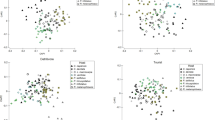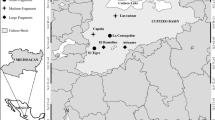Summary
Five sizes of canopy openings (0.016 ha to 10 ha) were established in the Southern Appalachian Mountains in early 1982 to examine the initial patterns of plant and arthropod establishment across a size range of forest disturbances. Vegetation standing crop after the first growing season was considerably higher in large than small openings in apparent response to greater resource release (e.g., sunlight) in larger openings. Woody stump and root sprouts were the dominant mode of revegetation in each patch size. Forest dominants such as Quercus rubra, Q. prinus and Carya spp. were less important as sprouters in openings than several minor forest components (e.g., Robinia pseudo-acacia, Acer rubrum, Halesia carolina and Cornus florida). Arthropod abundance and community composition varied across the size range of forest openings. Arthropods from the surrounding forest readily utilized the smallest canopy openings (0.016 ha). All feeding guilds were well represented in these small openings and herbivore biomass and load (mg of herbivores/g of foliage) were much higher than in larger patches. In contrast, arthropod abundance and species richness were significantly lower in mid-size than smaller patches. The relatively sparse cover and high sunlight in mid-size openings may have promoted surface heat buildups or soil surface/litter moisture deficits which restricted arthropod entry from the surrounding forest. Arthropod abundance and species richness were higher in large than mid-size patches. The greater vegetation cover in larger openings may have minimized the deleterious effects on arthropod populations. However, the absence of population increases among these arthropod species maintained herbivore loads at very low levels in large patches. Our results suggest that arthropod abundance and diversity in sprout-dominated forest openings are highly dependent on the extent of environmental differences between patch and surrounding forest.
Similar content being viewed by others
References
Ash JE, Barkham JP (1976) Changes and variability in the field layer of a coppiced woodland in Norfolk, England. J Ecol 64:697–712
Boring LR, Monk CD, Swank WT (1981) Early regeneration of a clear-cut southern Appalachian forest. Ecology 62:1244–1253
Boring LR, Swank WT (1984) The role of black locust (Robinia pseudo-acacia) in forest succession. J Ecol 72:749–766
Bormann FH, Likens GE (1979) Pattern and process in a forested ecosystem Springer, Berlin Heidelberg New York
Braun EL (1950) Deciduous forests of eastern North America. Hafner, New York
Brokaw NVW (1987) Gap phase regeneration of three pioneer tree species in a tropical forest. J Ecol 75:9–19
Brown VK, Southwood TRE (1983) Trophic diversity, niche breadth and generation times of exopterygote insects in a secondary succession. Oecologia 56:220–225
Bruce RC, Boyce SG (1984) Measurements of diversity on the Nantahala National Forest. In: Cooley JL, Cooley JH (eds) Natural diversity in forest ecosystems. University of Georgia Press. Athens, Georgia, pp 71–85
Buckner CA, Shure DJ (1985) The response of Peromyscus to forest opening size in the southern Appalachian Mountains. J Mamm 66:299–307
Canham CD (1989) Different responses to gaps among shade-tolerant tree species. Ecology 70:548–550
Canham CD, Marks PL (1985) The response of woody plants to disturbance: patterns of establishment and growth. In: Pickett STA, White PS (eds) The ecology of natural disturbance and patch dynamics. Academic Press, Orlando, Florida, pp 197–216
Carmer SG, Swanson MR (1973) An evaluation of ten pairwise multiple comparison procedures by Monte Carlo methods. J Am Stat Assoc 68:66–74
Coley PD, Bryant JP, Chapin FS III (1985) Resource availability and plant antiherbivore defense. Science 230:895–899
Collins BS, Dunne KP, Pickett STA (1985) Responses of forest herbs to canopy gaps. In: Pickett STA, White PS (eds) The ecology of natural disturbance and patch dynamics. Academic Press, Orlando, Florida, pp 217–234
Collins BS, Pickett STA (1988) Demographic responses of herb layer species to experimental canopy gaps in a northern hardwoods forest. J Ecol 76:437–450
Connell JH (1978) Diversity in tropical rain forests and coral reefs. Science 199:1302–1309
Coyle FA (1981) Effects of clearcutting on the spider community of a Southern Appalachian forest. J Arach 9:285–298
Denslow JS (1980) Patterns of plant species diversity during succession under different disturbance regimes. Oecologia 46:18–21
Denslow JR (1985) Disturbance-mediated coexistence of species. In: Pickett STA, White PS (eds) The ecology of natural disturbances and patch dynamics. Academic Press, Orlando, Florida, pp 307–323
Forman RTT, Galli AE, Leck CF (1976) Forest size and avian diversity in New Jersey woodlots with some land use implications. Oecologia 26:1–8
Forman RTT, Godron M (1986) Landscape ecology. John Wiley & Sons, New York
Freund RJ, Littell RG (1985) SAS for linear models: a guide to the ANOVA and GLM procedures. SAS Institute, Cary, North Carolina, pp 74–84
Galli AE, Leck CF, Forman RTT (1976) Avian distribution patterns in forest islands of different sizes in central New Jersey. Auk 93:356–364
Godfray HCJ (1985) The absolute abundance of leaf miners on plants of different successional stages. Oikos 45:17–25
Horn HS (1966) Measurement of “overlap” in comparative ecological studies. Am Nat 100:419–424
Hunt EJ, Shure DJ (1980) Vegetation and arthropod responses to wastewater enrichment of a pine forest. Oecologia 47:118–124
Jackson LWR (1959) Relation of pine forest overstory opening diameter to growth of pine reproduction. Ecology 40:478–480
Janzen DH (1983) No park is an island: increase in interference from outside as park size decreases. Oikos 41:402–410
Keough MJ (1984) Effects of patch size on the abundance of sessile marine invertebrates. Ecology 65:423–437
Klein BD (1989) Effects of forest fragmentation on dung and carrion beetle communities in central Amazonia. Ecology 70:1715–1725
Lawton RD, Putz FE (1988) Natural disturbance and gap-phase regeneration in a wind-exposed tropical cloud forest. Ecology 69:764–777
Lenski RE (1982a) Effects of forest cutting on two Carabus species: evidence for competition for food. Ecology 63:1211–1217
Lenski RE (1982b) The impact of forest cutting on the diversity of ground beetles (Coleoptera: Carabidae) in the southern Appalachians. Ecol Entomol 7:385–390
Lenski RD (1984) Food limitation and competition: a field experiment with two Carabus species. J Anim Ecol 53:203–216
Marquis DA (1973) The effect of environmental factors on advance regeneration of Allegheny hardwoods. Ph.D. Thesis, Yale University, New Haven, Connecticut
Matson PA, Boone RD (1984) Natural disturbance and nitrogen mineralization: wave form dieback of mountain hemlock in the Oregon Cascades. Ecology 65:1511–1516
Mattson WJ (1980) Herbivory in relation to plant nitrogen content. Ann Rev Ecol Syst 11:119–161
McConnaughay KDM, Bazzaz FA (1987) The relationship between gap size and performance of several colonizing annuals. Ecology 68:411–416
Nelson TC, Zillgitt WM (1969) A forest atlas of the south. USDA Forest Service Publication, Southern and Southeastern Forest Experiment Stations
Paine RT, Levin SA (1981) Intertidal landscapes: disturbance and the dynamics of pattern. Ecol Monogr 51:145–178
Phillips DL, Shure DJ (1990) Patch size effects of early succession in Southern Appalachian forests. Ecology 71:204–212
Pickett STA (1980) Non-equilibrium coexistence of plants. Bull Torrey Bot Club 107:238–248
Pickett STA, White PS (1985) The ecology of natural disturbance and patch dynamics. Academic Press, Orlando, Florida
Romme WH, Knight DH (1982) Landscape diversity: the concept applied to Yellowstone Park. BioScience 32:664–670
Romme WH, Knight DH, Yavitt JB (1986) Mountain pine beetle outbreaks in the Rocky Mountains: regulators of primary productivity? Am Nat 127:484–494
Root RB (1973) Organization of a plant-arthropod association in simple and diverse habitats: the fauna of collards (Brassica oleracea). Ecol Monogr 43:95–124
Runkle JR (1981) Gap regeneration in some old-growth forests of the eastern United States. Ecology 62:1041–1051
Runkle JR (1982) Patterns of disturbance is some old-growth mesic forests of eastern North America. Ecology 63:1533–1546
Runkle JR, Yetter TC (1987) Treefalls revisited: gap dynamics in the southern Appalachians. Ecology 68:417–424
Schowalter TD (1985) Adaptations of insects to disturbance. In: Pickett STA, White PS (eds), The ecology of natural disturbance and patch dynamics. Academic Press, Orlando, Florida, pp 235–252
Schowalter TD, Webb JW, Crossley DA Jr (1981) Community structure and nutrient content of canopy arthropods in clearcut and uncut forest ecosystems. Ecology 62:1010–1019
Seastedt TR, Crossley DA Jr (1981) Microarthropod response following cable logging and clear-cutting in the southern Appalachians. Ecology 62:126–135
Seastedt TR, Crossley DA Jr, Hargrove WW (1983) The effects of low level consumption by canopy arthropods on the growth and nutrient dynamics of black locust and red maple trees in the southern Appalachians. Ecology 64:1040–1048
Shure DJ (1973) Radionuclide tracer analysis of trophic relationships in an old field ecosystem. Ecol Monogr 43:1–19
Shure DJ, Ragsdale HL (1977) Patterns of primary succession on granite outcrop surfaces. Ecology 58:993–1006
Shure DJ, Rhillips DL (1987) Litter fall patterns within differentsized disturbance patches in a southern Appalachian Mountain forest. Am Midl Nat 118:348–357
Simpson EH (1949) Measurement of diversity. Nature 163:688
Sokal RR, Rohlf FJ (1969) Biometry. Freeman, San Francisco, pp 265–267
Sousa WP (1984a) Intertidal mosaics: patch size, propagule availability, and spatially variable patterns of succession. Ecology 65:1918–1935
Sousa WP (1984b) The role of disturbance in natural communities. Ann Rev Ecol Syst 15:353–391
Southwood TRE (1966) Ecological methods. Methuen and Company, Ltd., London
Sprugel DG (1976) Dynamic structure of wave-regenerated Abies balsamea forests in the northeastern United States. J Ecol 64:889–911
Sprugel DG (1984) Density, biomass, productivity, and nutrientcycling changes during stand development in wave-regenerated balsam fir forests. Ecol Monogr 54:165–186
Strong DR, Lawton JH, Southwood TRE, (1984) Insects on plants, Harvard University Press, Cambridge, Massachusetts
Swank WT, Crossley DA Jr. (1988) Forest hydrology and ecology at Coweeta. Ecological Studies 66. Springer, Berlin Heidelberg, New York
Urban DL, O'Neill RV, Shugart HH Jr (1987) Landscape ecology. BioScience 37:119–127
Vitousek PM (1985) Community turnover and ecosystem nutrient dynamics. In: Pickett STA, White PS (eds) The ecology of natural disturbance and patch dynamics. Academic Press, Orlando, Florida, pp 325–333
Author information
Authors and Affiliations
Rights and permissions
About this article
Cite this article
Shure, D.J., Phillips, D.L. Patch size of forest openings and arthropod populations. Oecologia 86, 325–334 (1991). https://doi.org/10.1007/BF00317597
Received:
Accepted:
Issue Date:
DOI: https://doi.org/10.1007/BF00317597




